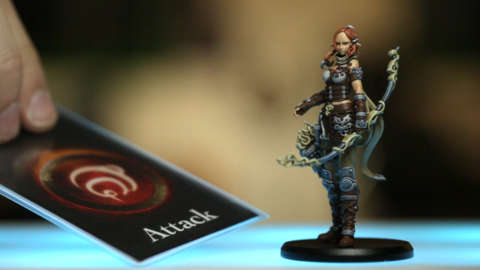Prodigy: Not Just Skylanders for Grown-Ups
Feel the magic.
The announcement trailer I'd seen for Prodigy before meeting with people from Hanakai Studios last week had left me with the impression that the game I'd be seeing was essentially Skylanders for grown-ups.
I was wrong.
Prodigy does have something in common with games like Skylanders and Disney Infinity. In this game, as in those, you place figurines on a platform, and the characters represented by those figurines then appear in the world of the game. However, that's where the similarities end. Prodigy is trying to bring the tactile and tactical pleasure of thoughtfully positioning pieces on a game board into the realm of video games. The role-playing game will have a single-player campaign, but my hands-on experience with Prodigy took the form of a turn-based battle against another player.
Marvel Rivals - Official Loki Character Reveal Trailer | The King of Yggsgard Remnant 2 - The Forgotten Kingdom | DLC Launch Trailer Stellar Blade - Official "The Journey: Part 2" Behind The Scenes Trailer | PS5 Games Fortnite Festival - Official Billie Eilish Cinematic Season 3 Trailer Dead by Daylight | Tome 19: Splendor | Reveal Trailer Starship Troopers: Extermination - Official "The New Vanguard" Update 0.7.0 Trailer 2XKO - Official Illaoi Champion Gameplay Reveal Trailer Destiny 2: The Final Shape | Journey into The Traveler Trailer Solo Leveling: Arise - Character Gameplay Teaser #15: Seo Jiwoo Genshin Impact - Character Demo - "Arlecchino: Lullaby" Goddess Of Victory: Nikke | Last Kingdom Full Animated Cinematic Trailer Metaphor: ReFantazio The King’s Trial Trailer
Please enter your date of birth to view this video
By clicking 'enter', you agree to GameSpot's
Terms of Use and Privacy Policy
In the full game, parties will be composed of three characters, but my opponent and I had just two units each, one of them being a guardian, who provides the mana that powers the party's special attacks (lose your guardian, and your other members are limited to their standard techniques). The boards before each of us had three rows of four squares each. Characters positioned in the front row received a bonus to damage dealt, while characters in the back row received a defensive bonus.

On each turn, only one character could act--my guardian, then my opponent's companion, then my companion, then my opponent's guardian, and so on. On a character's turn, he or she could move to any position on the board--done simply by picking the figure up and putting it down where I wanted the character to go--and then perform an action. Positioning was crucial not only because of the bonuses associated with certain rows, but also because placing one character in front of another can defend the character in the rear from attacks, and because some characters have special attacks that hit every character in a column, or all characters in a T formation. Actions were triggered not with presses of a button or clicks of a mouse, but by waving cards with symbols and words like "attack," "focus," and "power" over the board.
Of course, I've played plenty of video games in which I've had to carefully consider where to place my characters, but, just as computer chess can never completely duplicate the pleasure of sitting with a friend over a board of finely carved chess pieces, there is a different kind of pleasure that comes from picking up a figurine of a character and putting it down than the one that might arise from clicking and dragging a figure on a computer screen. The figurines I had the chance to examine were far more intricately detailed than the cartoony figurines of Skylanders and Disney Infinity; these are miniatures that would be at home in a tabletop, pen-and-paper role-playing game.
Prodigy hopes to make you feel drawn in to the fiction and magic of the game's fantasy setting--the game includes a ring of power that you wear, which stores information about your progress, though some information is stored in the miniatures, as well. Hanakai hopes that there's an interest in this meshing of the tangible and the digital, and is launching a Kickstarter campaign on April 2, at which time more information about Prodigy will be revealed.
Got a news tip or want to contact us directly? Email news@gamespot.com
Join the conversation